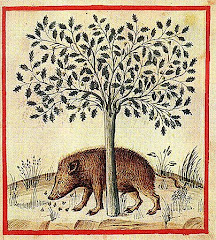
Going clockwise from the top, the wool in the photo has been dyed with: Brazilwood (Caesalpinia sp.), logwood (Haematoxylum campechianum), white onion (Allium cepa) and heather (Calluna vulgaris).
Apart from a range of other pigments, all these plants share a flavonoid content which significantly affects the overall colour they give. In fact, flavonoids are highly significant to nearly all plants as well as being extremely beneficial to our health. Consequently I've chosen them as the subject of this post.
Flavonoids can be broken down into several smaller groups of plant constituents which I'll deal separately at some point, but first I'd like to go backwards to try and understand what a flavonoid actually is. To do so I need to begin with a benzene ring - something which pops up time and again in the world of organic chemistry.
And so begins a grossly simplified explanation of where flavonoids come from:

Usually depicted with all the helpful labels removed, a benzene ring is essentially a compound made up of 6 Carbon atoms linked in a ring with a couple of Hydrogen atoms attached here and there to make it 'balance'. In fact, I think I'll do a separate post on how this works and link to it when complete. Apparently it's the benzene rings in molecules that are responsible for spicy scents and flavours and so groups of one or more benzene rings are all known as aromatic compounds.And so begins a grossly simplified explanation of where flavonoids come from:

 Going one step further and adding a hydroxyl group to a benzene ring will produce an aromatic alcohol or 'phenol'. And if you bung a load of phenols together you'll find you've got a 'polyphenol' shockingly enough.
Going one step further and adding a hydroxyl group to a benzene ring will produce an aromatic alcohol or 'phenol'. And if you bung a load of phenols together you'll find you've got a 'polyphenol' shockingly enough. But, and this is where it gets exciting, depending on the shape of your polyphenol and the various things attached to it, you may find you have a flavonoid. Here's an example of Kaempferol, a flavonoid which is more specifically a 'flavonol'.
 There's obviously a lot more to it than that. For example, what differentiates a flavonoid from other polyphenols is that it is based on a structure of two benzene rings connected by a bunch of 3 Carbons and maybe some other bits and bobs. I've tried to show which bits are which on the diagram above, but really my comprehension begins to dwindle at this point.
There's obviously a lot more to it than that. For example, what differentiates a flavonoid from other polyphenols is that it is based on a structure of two benzene rings connected by a bunch of 3 Carbons and maybe some other bits and bobs. I've tried to show which bits are which on the diagram above, but really my comprehension begins to dwindle at this point.So, what else is there to know about flavonoids?
Well, they come in several forms including flavonols (as depicted above), flavones, anthocyanins and isoflavones, but the differences between these groups and their individual uses will have to be the subject of a separate post.
As a group, flavonoids can produce anything from white and yellow through to red and blue pigmentation in plants. They are responsible for many yellow, red, pink, violet and blue flowers as well as the colours of autumn leaves.
Physiologically, flavonoids provide a whole range of services including protecting the plant from UV rays, inhibiting damaging enzymes, regulating growth and defending against insects and microbes. Their significance to plant health is evidenced by the fact that production is increased near sites of infection or injury.
As for their effect on humans, flavonoids are a key component of our everyday diet. It is thought that we eat 1 gram of flavonoids every day on average although there are doubts about our ability to absorb a large portion of it. Having said that, flavonoids are essential to a healthy diet and the number of known and potential benefits is far too great to do justice to.
The most famous effects however are to the heart and circulatory system so I aim to cover these health benefits of flavonoids and more soon.

















